The ‘key trait’: having one gill cover or several gill covers
(as in sharks, Fig. 1) turns out to be a trivial trait in a matrix of 235 traits in the large reptile tree (= LRT, subset Fig. 2). Only one gene has to change to make one type of gill or the other as recently documented (see below).
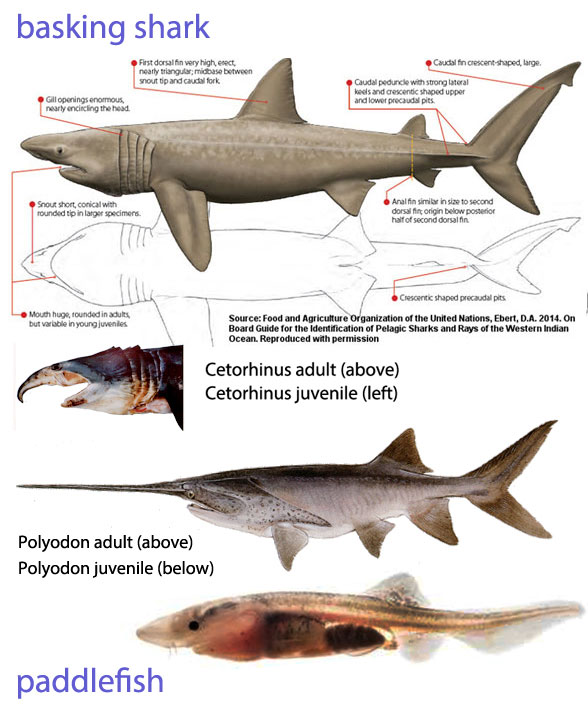
What does ‘closely related’ actually mean?
No other tested taxon shares as many traits with paddlefish (Polyodon) as the basking shark (Cetorhinus, Fig. 1) in the LRT. Someday a taxon might be added that nests between them. At present such taxa remain unknown and untested. Both taxa are derived from the Polyodon hatchling taxon (Fig. 3), which has a shorter rostrum and a more basking shark-like appearance overall. Back in the Silurian, pre-paddlefish hatchlings were likely much smaller and adults were likely the size of present day hatchlings, but that’s not a requirement. No other analysis that I am aware of has ever included paddlefish hatchlings as taxa, but that morphology is key to understanding various lineages within Chondrichthyes. So, here’s a case where adding a taxon is much more important than adding a character.
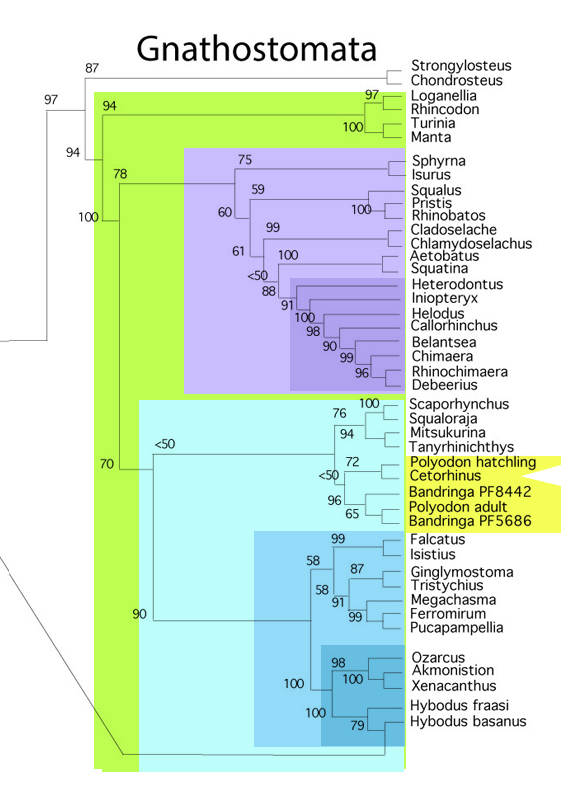
Note the gelatinous rostrum
in the paddlefish juvenile (Fig. 1). That trait is retained from mako sharks (Figs. 3, 6, as we learned earlier here. The rostrum of the adult basking shark is likewise filled with gelatin supported by a thin frame of cartilage (Fig. 4). The shark-like appearance of paddlefish has been noted previously. Previously the presence of one enormous gill cover in paddlefish has excluded them form prior shark studies. The LRT minimizes such taxon exclusion by simply adding taxa.
We’ve always known
that ratfish (with one gill cover, Fig. 3) nest with sharks (with several gill covers separating slits). No one has complained about that yet.
Then we learned
that sturgeons and Chondrosteus (with one gill cover, Fig. 3) nest basal to whale sharks and mantas (with several gill covers). The pattern of gill covers was presented and revised recently here.
Now
paddlefish (Polyodon) nests with basking sharks (Cetorhinus, Fig. 1) in the large reptile tree (LRT, 1785+ taxa, subset Fig. 2). Evolution is full of such trivial exceptions.
Paddlefish inhabit rivers. Basking sharks inhabit the sea.
They both feed the same way. Basking sharks reach 30 feet in length. Paddlefish reach 7 feet in length. The two likely went their separate ways in the Silurian (prior to 420mya), so they had plenty of time to evolve on their own since then.
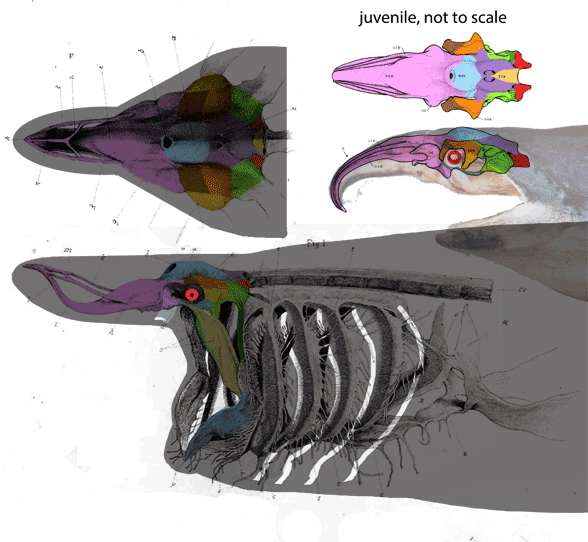
A recent study on gill covers by Barske et al. 2020
“identify the first essential gene for gill cover formation in modern vertebrates, Pou3f3, and uncover the genomic element that brought Pou3f3 expression into the pharynx more than 430 Mya. Remarkably, small changes in this deeply conserved sequence account for the single large gill cover in living bony fish versus the five separate covers of sharks and their brethren.”
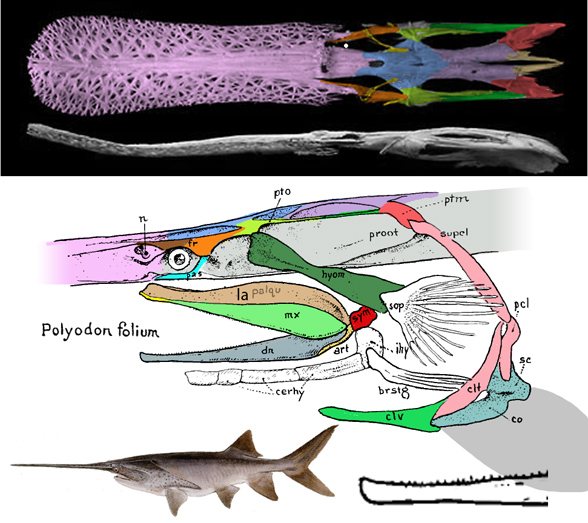
While comparisons to the feeding technique in paddlefish and basking sharks
appear in the literature (Matthews and Parker 1950, Haines and Sanderson 2017), these were presumed to be by convergence based on the single gill cover vs. multiple gill cover difference.
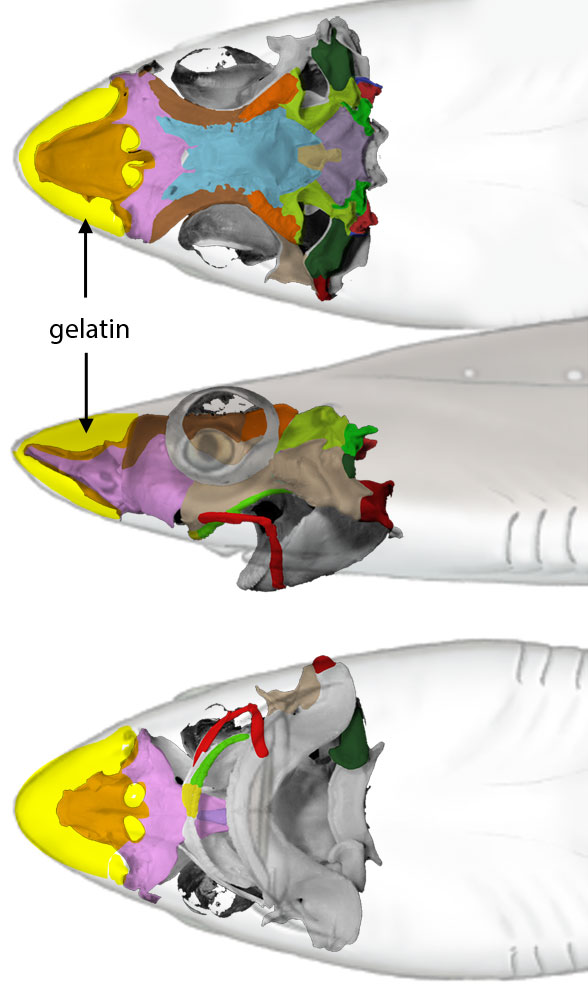
Relying on one, two or a dozen traits
to trump the other 234, 233 or 213 is called “Pulling a Larry Martin.” You don’t want to do that. Put aside your traditions, add taxa and let the unbiased software figure out where your taxon nests using the widely accepted hypothesis of maximum parsimony (= fewest changes) over a large set of character traits.
The present hypothesis of interrelationships
(Fig. 2) appears to be novel. If not, please advise so I can promote the earlier citation.
References
Barske L et al. (10 co-authors) 2020. Evolution of vertebrate gill covers via shifts in an ancient POU3f3 enhancer. PNAS 117(40):24876–24884.
Haines GE, Sanderson SL 2017. Integration of swimming kinematics and ram suspension feeding in a model American paddlefish, Polyodon spatula. The Journal of Experimental Biology, 10.1242/jeb.166835, 220, 23, (4535-4547), (2017).
Matthews LH, Parker HW 1950. Notes on the anatomy and biology of the basking shark (Cetorhinus maximus (Gunner)). Proceedings of the Zoological Society of London 120(3):535–576.


This has to be satire
“We’ve always known
that ratfish (with one gill cover, Fig. 3) nest with sharks (with several gill covers separating slits). No one has complained about that yet”
ya “WITH” NOT “WITHIN”
Ratfishes Are Within The Class Chondrichthyes
Ratfishes Are Holocephali While Sharks and Rays are in Elasmobranchii
Also, have you guys ever heard of Convergent Evolution?
Sure Sturgeons and Paddlefish are Superficially Similar to Shark But, Sturgeons and Paddlefish are in a Different Class They are in Osteichthyes
this is like saying Dinosaurs(Birds) Are Pterosaurs Because Both groups Fly
Welcome, Michael. You are indicating this comes as a shock to you. You are reporting what you have read, not yet accustomed to the paradigm shift. I am reporting what I have tested, that others have not tested. Run your own tests with similar taxon lists and let us know what you get.
What about the skeletons? Basking sharks have skeletons made of cartilage, well paddlefish have skeletons made of bone. Wouldn’t this provide evidence for them being farther apart then your tree suggests?
cartilage vs bone = chemistry. I deal with morphology alone. Remember sharks are derived from sturgeons, which are typically considered ‘bony fish’. Other bony fish are all derived from hybodontid sharks in the LRT, which fossilize better than most sharks. While your hypothesis is the current paradigm and consensus, the LRT presents shape, ratio and placement evidence. On a similar note, you haven’t mentioned the single vs multiple gill openings. That also varies as documented by ratfish and the above-mentioned lineages. Preconceptions are a problem. Let your software tell you the tree topology. That’s what it is there to do: to crunch the numbers.
Despite paddlefish and sturgeons traditionally being part of the superclass Osteichthyes (bony fish), Both paddlefish and sturgeons have cartilaginous skeletons, not made of bone.
Try adding the Chinese paddlefish (Psephurus gladius). It might help recovering sturgeons with paddlefish as it should be.
“as it should be”? Quick look shows no returns for “Psephurus gladius skull”. Parapsephurus willybemisi from North Dakota comes up, but I see no sturgeon traits. Do you? Let us know your short list of sturgeon traits in any paddlefish. If you’re working from tradition or textbooks, maybe that’s not good enough anymore, according to the LRT, which employs a wider gamut of generic (not suprageneric) taxa based on traits.
I don’t know, but excluding the osteoderms and the paddle, the body looks almost identical.
Plus, you are omitting taxa. You didn’t score basal paddlefish like Protopsephurus that look even more sturgeon-like. If you need characters for the Chinese paddle fish and for Protopsephurus, check https://doi.org/10.1671/0272-4634(2002)022%5B0209:PLAWPP%5D2.0.CO;2 . These two groups are very clearly related.
Sech, I appreciate your excitement on this topic, but you do realize sturgeons are jawless taxa, while paddlefish have jaws? Even so, I just found good data for Protosephurus. It’s on the list and will be DGS’d shortly.
You wrote, “These two groups are very clearly related.” Can you provide a cladogram to support this hypothesis that includes a taxon list similar to that of the LRT?
Dave, no, sturgeons DO have jaws, they are just modified. They simpley have protrusible jaws like many other fish like koi, and nobody (not even you) says koi fish are agnathes. And no, nobody will do a phylogenetic analysis that includes both pterosaurs and sturgeons, therefore I don’t have a cladogram that supports that hypothesis with that exact taxon list. But, at least for me, the fact that both can hybridize and that both genomic and previous morphological analyses nest them together is enough evidence to say they are closely related.
No one claims sturgeons are related to koi. The LRT does not support that interrelationship. No one said anyone has to do an analysis with pterosaurs and sturgeons. Just calm down, buckle down and include the pertinent taxa. Do the work then we’ll compare results. A dozen taxa will probably be enough. See the LRT for taxon list clues. Here are some sturgeons: http://reptileevolution.com/pseudoscaphirhynchus.htm
Sturgeon mouth parts (lacrimal and angular) are ventral. They essentially open and close the ‘bomb bay” from which an extensible suction tube emerges, closer to ostracoderms. On a similar note, Protopsephurus entered the LRT with spoonbills without moving the sturgeons.
I know this can be confusing. Sturgeons also have ray fins. Experts have put spoonbills together with sturgeons forever, so you’re in the majority, following tradition. Adding taxa that have never been tested together in the LRT recovers a different hypothesis of interrelationships. So add the pertinent taxa. Let us know what you come up with and we’ll discuss the issue. I’m willing to change. That’s why I say the LRT requires testing for confirmation, refutation or modification.
Hybridization? I covered that here: https://pterosaurheresies.wordpress.com/2020/07/19/sturgeon-paddlefish-sturddlefish/ when the LRT had fewer taxa. I showed the results of that study. The young skewed strongly to sturgeon from the outside. No skull data was provided. I can only guess that the sperm ‘inspired’ the sturgeon eggs to divide and grow to become sturgeons. Let’s continue to follow that story.
I never said koi and sturgeons were closely related. They clearly aren’t. What I am saying is that sturgeons, like koi, do have jaws. The only thing is they look weird because they are modified to be protrusible jaws. Following your logic, koi should also be agnathes since they have a similar mouth adaptation that would make them appear jawless.
Compare these two.
And on the other hand, here you have what a real agnathe mouth looks like (just a hole)
Actually , I like that sturgeon mouth picture because it shows that the mouth only seems to be ventrally oriented because of the snout. If you remove that snout and displace the mouth a little upwards it looks like a very average fish mouth
Here’s another.
The mouth is articulated. It has a hinge that opens it and closes it. It just looks weird because it is protrusible, but that is quite common with fish.
Unlike (again) a real agnathe, like this hagfish, which only has a hole that doesn’t move.
https://content.presspage.com/uploads/1369/1920_modernhagfishhead-792297.jpg?10000
OK. Let’s start from that point and move forward. The LRT scores several traits for general proportions (e.g. nasal extends beyond oral). Since fossil taxa are employed skull traits are employed. If you’re going to dispute LRT results, let’s move into skull and skeleton data. Can we do that? Also, since the LRT employs genus- and species-based taxa, let’s do the same in this discussion. Let’s avoid suprageneric taxa like ‘Agnatha’, which can include, in this case, gnathostomes. Finally, photos are not going resolve this issue, but a competing cladogram with a .nex file will resolve this issue.
Ok, let’s move to skull data then.
First of all, your bone identification in the Polyodon and sturgeon skull diagrams are wrong and you need to change those scorings. Neither paddlefish nor sturgeons have premaxilla. The traditional identity of the upper jaw bone is the maxilla, but according to a 2011 study based on analyzing both adult skulls and the patterns of development of these bones, it is actually the dermopalatine. The group lost both the maxilla and premaxilla and they got replaced by the dermopallatine. But even if you choose the other option, that bone is a maxilla, not premaxilla. The absence of premaxilla is doubtless.
And second, sturgeons, paddlefish and koi have pretty much the same jaw bones (excluding that dermopalatine substitution) even according to your diagrams. However, a lamprey (a true jawless taxon) doesn’t have any of those bones. It only has an unarticulated hole. And I don’t understand how your LRT scored taxa in this order: lamprey (with a simple unarticulated opening, just a hole), sturgeons (with jaws and jaw bones in the same configuration as paddlefish (talking about the dermopalatine) and other fish) and then Drepanaspis (https://reptileevolution.com/images/vertebrates/dunyu-skull588.jpg), which, again, has only a simple and unarticulated hole like lamprey.
I would seriously consider scoring these taxa’s (Polyodon and Ascipenser) skulls again. Here you have that 2011 paper on the identity of those jaw bones in Acipenseriformes in case you would consider re-scoring them: https://doi.org/10.3158/2158-5520-3.1.1
And btw, I find it funny that you mention the trait “nasal extends beyond oral” because that trait is shared by both sturgeons and paddlefish (I wonder why).
And finally, on the hybridization article, I guess you didn’t read it or didn’t interpret it correctly.
Those 4 specimens are all 1 year old, not the same one from younger to older as you said in your post. The first individual is a pure sturgeon and the last individual is a pure paddlefish. The second individual is a large genome hybrid individual and the third one a small genome hybrid individual. What is this large and small genome thing? They realized that within the hybrids there were two types: ones that looked much more sturgeon like and ones that looked more like a 50/50 mix. They took both groups and analyzed their genomes, and they found out that:
1. They WERE hybrids. They indeed had paddlefish DNA and confirmed the hypothesis that they were hybrids and not just sturgeons as you suggested and as they initially intended.
2. The ones that looked very sturgeon-like (individual 2) had double the amount of sturgeon DNA due to a chromosome duplication event. These were called large genome.
3. The ones that looked like a 50/50 mix (individual 3) had roughly the same amount of sturgeon and paddlefish DNA. These were called small genome.
And I don’t understand why you say they look just like normal sturgeons. The large genome hybrids indeed look very sturgeon like. But come on Dave, the small genome hybrids look like a complete mix: long snout (paddlefish trait), black color (paddlefish trait), slender shape (paddlefish trait), and reduced armor, but overall more sturgeon-like shape. With hybrids it’s normal for one of the two species to be dominant (in this case sturgeon), but they clearly have mixed traits.
I know you will go to bed thinking sturgeons are jawless, but at least I hope you can consider re-scoring them.
Hi Sech,
Because tetrapods lack a dermopalatine, I break with tradition and label no bone in any tested taxon a dermopalatine.
Chiefly that structure is homoloogized with the tetrapod lacrimal. Tooth-bearing portions are mere ‘painted on’ layers (visible on Polyodon young and shark outgroups, lost in filter-feeding adults). The median tooth-bearing layer (often not separate from the lacrimal) is the premaxilla. The lateral are the maxilla. The lacrimal never develops teeth. The identity of a premaxilla in paddlefish juvenile goes back to Entelognathus. You’re playing by old rules and bone IDs.
re: the hybrids, let me get back to you as I take a moment to review that study.
Hi Sech,
This quote from the Kaldy et al 2020 report on paddlefish – sturgeon hybridization:
“Although hybridization among acipenserid species is common, there are no reports of successful hybridization of acipenserids and polyodontids. Previous hybridization experiments on shovelnose sturgeon (Scaphirhynchus platorynchus) × American paddlefish [12,13] or American paddlefish × Amur sturgeon (Acipenser schrenckii) [14] have failed to result in viable offspring.
Besides the large phylogenetic distance (i.e., they diverged 184.4 Mya [15]), representatives of Polyodontidae and Acipenseridae differ in their gross morphology (e.g., presence of scutes, the structure of mouth, rostrum, filter apparatus) as well as feeding behavior, preferred habitat, etc. [3,16].
This suggests an inability to hybridize.
During an experiment to produce gynogenic Russian sturgeon progeny, a negative control was initiated using non-irradiated American paddlefish sperm and eggs from the Russian sturgeon. Unexpectedly, the control cross resulted in viable hybrids.”
Definition: “Gynogenesis: a form of parthenogenesis, is a system of asexual reproduction that requires the presence of sperm without the actual contribution of its DNA.”
The take-away here is: “large phylogenetic distance.” So experts don’t argue for a close interrelationship. Do you disagree with Kaldy et al? Do you maintain a close phylogenetic distance?
In the LRT other taxa, both extinct and extant, are closer to paddlefish and closer to sturgeons than they are to each other. With that in mind, a follow-up experiment should attempt to hybridize basking sharks and paddlefish. Another experiment should attempt to hybridize lampreys and sturgeon.
Meanwhile… Peipiaosteus was nested as a last common ancestor of sturgeons and paddlefish by Liu and Zhou 1965. I will add Peipiaosteus to the LRT and maybe that taxon will bring sturgeons and paddlefish together. Does that work for you? I’m keeping an open mind here. I hope you will, too. Thank you for bringing this situation to my attention. Together we’ll solve this issue.
PS: I wrote to the lead author of the Kaldy et al report for more information.
Dave, I want to remind you that the identity of that bone as the dermopalatine is backed by observing it’s development and because it is the most parsimonious explanation. From Hilton, E. et al. (2011) (I encourage you reading it, specially the part of the permaxilla and the synapomorphies of Acepenseriformes. doi.org/10.3158/2158-5520-3.1.1 )
“The identification of the bones that make up the dorsal oral
jaws in Acipenseriformes has recently been discussed by
Grande et al. (2002, p. 225), which we quote here (with
omission of their figure references): ‘‘The upper jaw of
{Protopsephurus [and other acipenseriforms] consists of two
major bones: the palatopterygoid, and another bone termed
maxilla in Grande and Bemis (1991) but later (Grande &
Bemis, 1996; Bemis et al., 1997; and here) termed dermopalatine. Our interpretation of this bone as a dermopalatine is
based on its pattern of development and its topographically
close association with the palatatoquadrate (e.g., Bemis et al.,
1997, fig. 18). Such studies show that, as in other actinopterygians, the dermopalatine of acipenseriforms forms in close
association with the palatoquadrate cartilage, which it
partially ensheathes. Were we to interpret this bone in the
traditional way, as a maxilla, we then would be postulating
not only that dermopalatines were lost phylogenetically in
Acipenseriformes but also that the maxilla of Acipenseriformes secondarily evolved an unusually close contact with
the surface of the palatoquadrate cartilage. In view of the
available comparative anatomical and developmental data, it
seems simpler to us to interpret this condition as resulting
from only one change (loss of the maxilla), with the
dermopalatines being retained in their plesiomorphic position
as ensheathing elements of the palatoquadrate cartilage. This
view is also consistent with the unquestioned absence of the
premaxilla in acipenseriforms, an element that is primitively
present in osteichthyans.’’
As noted above, the absence of these bones has been used in
prior systematic analyses (e.g., Grande & Bemis, 1996,
character B8; Grande et al., 2002, character 15) and found
to be a synapomorphy of Acipenseriformes, as it was in our
analysis.”
This trait is present in both groups. And regarding teeth, I would like to remind you that baby sturgeons also have teeth.
And with the “large phylogenetic distance” part, you are misinterpreting it. It is a large distance from the standpoint that they are sepparate families (Polyodontidae vs Acipenseridae) and that they diverged that long ago, but that doesn’t make them unrelated. They are each other’s closes relatives (supported by basically any recent analysis with both morphology and/or genomics). They haven’t changed that much since their divergence and that is why they can still interbreed.
And you know what else is evidence against the shark affinities of paddlefish and support for Acipenseriformes? Their eggs and mating style. In your tree, Polyodon nests more derived than Rhincodon and less derived than Chimaera. What do Rhincodon and Chimaera have in common? They both lay your typical chondrichthyan eggs and have internal fertilization (inside the female).
https://content.api.news/v3/images/bin/ffbc59c25cc27a2805b7cd2a4b744c37
Based on your hypothesis the next logical step is that Polyodon would lay the same type of eggs and would have internal fertilization as well right? Well, surprise, Polyodon produce caviar (like sturgeons, which at the same time are like the rest of ray-finned fish eggs) and have external fertilization.
That doesn’t make sense following your hypothesis.
No bones in the LRT are labeled ‘palatoquadrate’ because no tetrapods have a ‘palatoquadrate’. Egg-laying patterns change in fish and the LRT does not test egg-laying patterns. Fish have been around a long time. Reversals. Convergence. Phylogenetic miniaturization. Neotony. All are possible. Trace the skulls and skeletons. Add pertinent taxa. You can’t just eyeball this or rely on traditions based on taxon exclusion and call it a competing analysis. Compete with a similar taxon list. Repeat the experiment. Find out for yourself what I found out. I look forward to seeing you nest Polyodon with Acipenser in the presence of competing taxa from the LRT.
That’s the problem, and it’s the problem everybody is trying to tell you. You are testing fish in a tetrapod matrix with tetrapod characters. Your character scoring is wrong an has insufficient characters. How can you score adequately fish bones in a matrix that is not adequated to score fish bones? You can have as many taxa as you want, but if your scoring is wrong, your results are going to be wrong as well. I repeat, check https://doi.org/10.3158/2158-5520-3.1.1 for sturgeon and Acipensiformes anatomy. If you had the right bones in your matrix and you scored both, sturgeons and paddlefish, correctly, they would nest together because they share the traits discussed in the paper I’ve copypasted multiple times. We can’t come to an agreement because your scorings and identification of the bones are wrong from the begining. Just to experiment, score both Acipenser and Polyodon with the cranial traits and identities in the paper I showed you and you tell me how they nest. Greetings.
Sech, You wrote, “Your character scoring is wrong an has insufficient characters. How can you score adequately fish bones in a matrix that is not adequated(sic) to score fish bones?”
You’re just going to have to get used to this new reality. In order to test fish with non-fish a common alphabet and identifier had to be erected.
To your point, I was not able to download the paper you linked to, but I have a similar and more recent paper by one of the co-authors (Hiton): “When Tradition Meets Technology: Systematic Morphology of Fishes in the Early 21st Century”. The sturgeon skull bones are colorized – but not with standardized colors, so that’s good. The homology of oral bones is key to your argument. No teeth = no dentary, not premaxilla, no maxilla in these basal vertebrates. Teeth show up later.
re: baby sturgeon teeth… I wondered about that, too. Turns out those teeth are not dentine and enamel, as found in gnathostomes, but are closer in structure to lamprey teeth.
The details matter. So does a wide gamut of taxa. On that note, let’s say Acipenser and Polyodon do nest together… between which taxa in your view? Somewhere in sharks? in Ray fins? somewhere else?
Just found the Fieldiana paper on sturgeon anatomy. Expect a blogpost on that topic.
I don’t understand the need to test fish in the same study as tetrapods (excluding, of course, fish near the base of Tetrapoda). I understand the homology thing though. But even with that, the problem I am pointing out here is the identity of the skull bones. What you identify as premaxilla in sturgeons and as maxilla in paddlefish should be “lacrimal” (dermopalatine) in both, since this bone replaced both the premaxilla and the maxilla. Neither of them have maxilla nor premaxilla, and that is agreed by most people who study these fish (convergence or synapomorphy, you decide). And yes, that detail of the bone identities is crucial to do a phylogeny.
“No teeth = no dentary, no premaxilla, no maxilla”
They do have teeth, the only thing is they loose them when they reach 3 cm (like paddlefish!). And it is also important to say that (as you might already know), teeth are not necessarily bonded with maxilla/dentary/premaxilla. They appeared first as dermal structures and then they migrated towards the mouth. Actually, sturgeons (I don’t know if paddlefish as well) have teeth in their gills. And their mouth teeth appear on the dentary and on the dermopalatine (“lacrimal”).
“Turns out those teeth are not dentine and enamel, as found in gnathostomes, but are closer in structure to lamprey teeth”
Do you have any references for that? I couldn’t find any. Though I don’t think so. Lamprey teeth are made out of keratin. Sturgeons also having keratin teeth would be very strange and would indeed make everybody raise an eyebrow.
And I am glad that you could access the article, I’ll wait for the addition of that information to your sturgeon and paddlefish scoring.
Sech, Thank you for waiting. Several revisions going on.